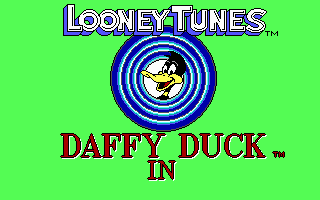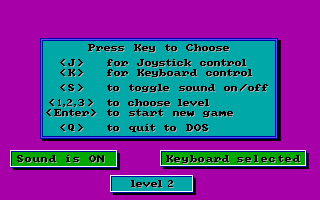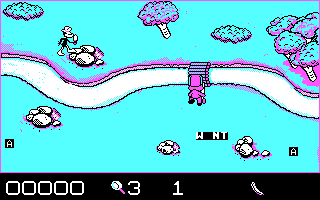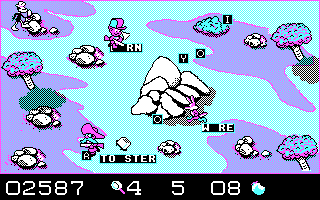Retro Replay Review
Gameplay
Daffy Duck, P.I.: The Case of the Missing Letters blends educational objectives with lighthearted action, putting young players in the beak of everyone’s favorite duck detective. Each screen presents a new thematic environment—ranging from a dusty desert town to a spooky haunted mansion—where letters are scattered randomly among words with missing characters. Your mission is simple: guide Daffy to pick up the correct letter and place it into its matching word slot. The straightforward pick-and-drop mechanic ensures accessibility for children, while the gradual increase in word length and complexity keeps them engaged.
Adding spice to the letter-collecting routine are classic Looney Tunes adversaries such as Elmer Fudd, Sylvester J. Pussycat, Yosemite Sam, and Wile E. Coyote. These foes patrol the screens, ready to send Daffy back to the start if they collide. Fortunately, Daffy can defend himself using playful weapons like bananas and eggs, stunning enemies just long enough to complete a tricky word. This mild combat sequence introduces an element of timing and quick reflexes, giving the game a subtle action twist without overwhelming its educational focus.
Between main stages, bonus levels invite players into a timed grid of letters where they must trace words in classic word-search style. Each discovered word awards points, and every thousand points grants an extra life—an incentive to hone vocabulary skills and pattern recognition. With three selectable difficulty levels, families can tailor the challenge: younger kids might stick to Easy mode to build confidence, while more seasoned players can tackle Hard for a faster pace and tighter time limits.
Graphics
The visual style of Daffy Duck, P.I. is immediately recognizable as Looney Tunes, featuring bright, cartoonish sprites set against colorfully detailed backdrops. Every location feels distinct—whether it’s the windswept plains of Sam’s territory or the dimly lit corridors of a ghostly castle—helping to maintain visual interest over multiple screens. Letter tiles pop against the environment, ensuring clarity, and the word slots are cleanly designed so that young eyes can easily differentiate between missing and filled words.
Character animation is charmingly fluid, with Daffy’s trademark wobble and flail preserved in every jump and weapon toss. Enemies don’t simply stand still; Elmer Fudd tiptoes, Sylvester paces back and forth, and Wile E. Coyote cackles before making a dash. These small touches pay homage to the original cartoons and enrich the game world with familiar personality. Background elements often include subtle Easter eggs—a falling piano or a sneaky Acme rocket—that Looney Tunes fans will appreciate.
Though the color palette leans toward primary hues suitable for an audience of children, the designers manage to incorporate enough shading and detail to prevent environments from feeling flat. Letter tiles have a slight 3D effect, making them appear as tangible objects Daffy can scoop up. Overall, the graphics strike a balance between simplicity for readability and enough visual flair to keep players engaged on every level.
Story
The narrative premise—letters have run away from their words and are hiding across various locales—is delightfully whimsical and easy for kids to grasp. Daffy Duck steps into the role of a private investigator, complete with a trench coat and magnifying glass, lending a playful noir flavor to the proceedings. While the storyline is light and straightforward, it provides enough context to motivate the letter-hunting objective and track progression from one themed area to the next.
Rather than delivering lengthy cutscenes or complex dialogue, the game relies on brief introductions and congratulatory messages between levels to carry the plot forward. This ensures that flow isn’t disrupted and players remain focused on the core educational challenges. Occasional quips from Daffy—presented as captioned thought bubbles—add humor and keep the tone reminiscent of a classic Looney Tunes short.
Although the story doesn’t delve into deep character development, it leverages beloved personalities in just the right way. The presence of fan-favorite antagonists provides small narrative hooks (“Can you outsmart Yosemite Sam’s quick draw?”), making each location feel like a new chapter in a Daffy Duck mystery. For an educational action game aimed at younger audiences, the story hits all the right notes without overstaying its welcome.
Overall Experience
Daffy Duck, P.I.: The Case of the Missing Letters shines as an educational action title that balances learning with lighthearted fun. Kids practice spelling, letter recognition, and word formation while guiding a beloved cartoon character through a series of charming levels. The threat of being stunned by classic villains adds a dash of excitement, and the bonus word-search grids offer an optional brain-teaser for more advanced players.
The three difficulty settings and built-in high score table encourage replayability, letting families track improvement or challenge siblings to beat each other’s records. Extra lives earned through bonus rounds mitigate frustration on tougher screens, and the forgiving learning curve means that even reluctant readers can find success after just a few tries. Parents will appreciate the wholesome humor, recognizable characters, and non-violent ‘combat’ elements.
Overall, this title delivers an age-appropriate blend of entertainment and education, wrapped in the zany world of Looney Tunes. Its intuitive controls, memorable animations, and clever word-based puzzles make it a strong pick for households seeking screen time that’s both fun and instructive. Whether you’re a longtime fan of Daffy Duck or simply looking for a playful way to reinforce literacy skills, this game is well worth investigating.
 Retro Replay Retro Replay gaming reviews, news, emulation, geek stuff and more!
Retro Replay Retro Replay gaming reviews, news, emulation, geek stuff and more!









Reviews
There are no reviews yet.